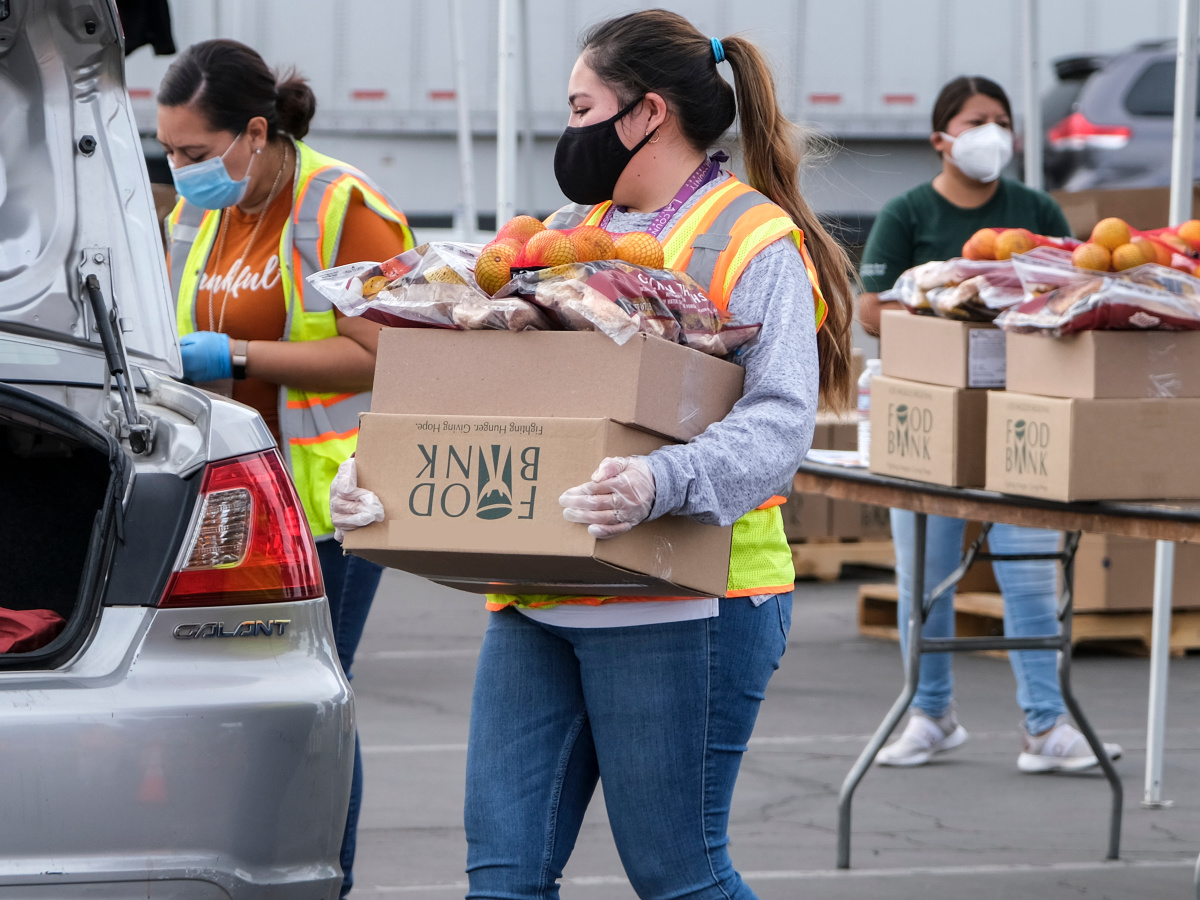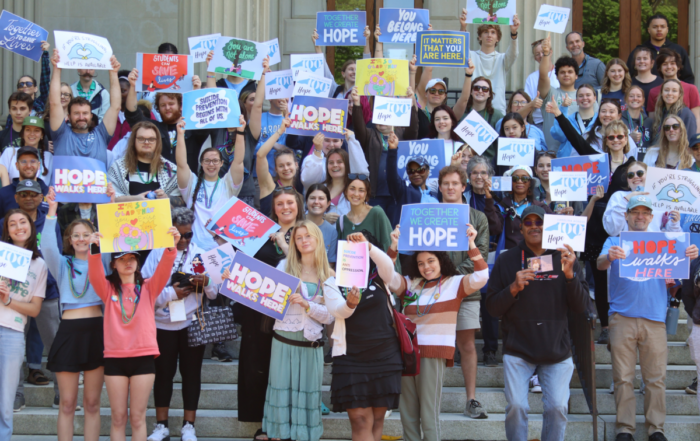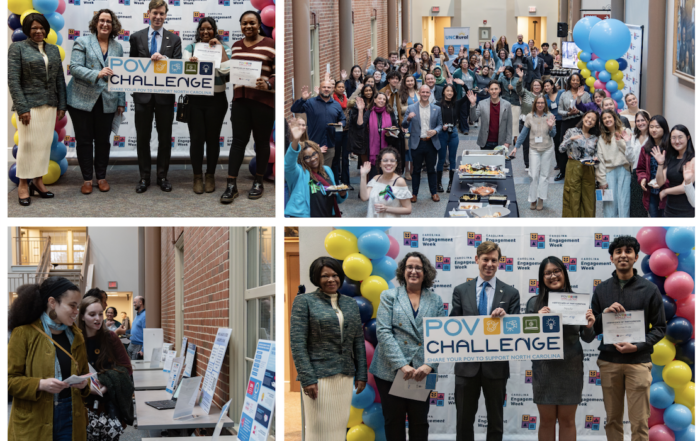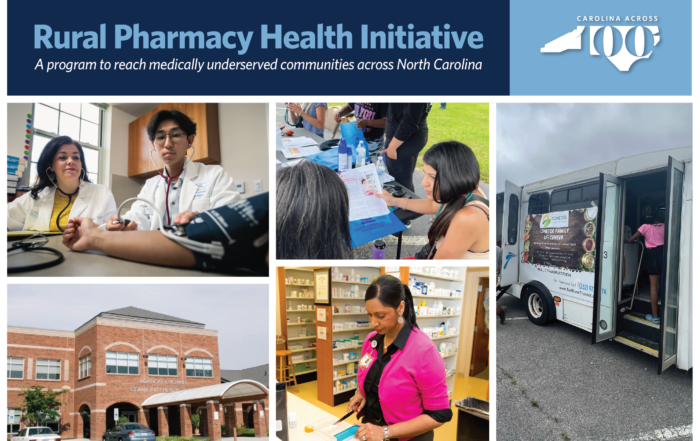Food Insecurity
The State of Food Insecurity in North Carolina During the Pandemic
Maureen Berner, Professor of Public Administration and Government
December 21, 2021
Residents wait in line to receive food at Chatham Outreach Alliance in Pittsboro. Kim Hawks, Carolina Public Press

Many of us have skipped retail coffee or lunch to save a few dollars or to save up for a luxury. For other North Carolinians, however, the cost of consistently putting food on the table competes with other necessary financial demands – things like heating bills, health care costs, or rent or mortgage payments. Food is a ‘flexible but necessary’ expenditure because we can trade off food spending for other needs in the (very) short term. Food insecurity is the formal measure for this situation, defined by the USDA as the limited or uncertain availability of nutritionally adequate and safe foods, or limited or uncertain ability to acquire acceptable foods in socially acceptable ways.
In 2000, 1 in 10 Americans were food insecure. A few years later, food insecurity jumped 50% with the 2008 Great Recession. In response to public and private non-profit efforts to address the growing hunger problem, food insecurity slowly fell back to pre-Great Recession levels by 2019. The official statistics may not give the full picture. Even across these same years, demand on North Carolina food banks and their partner agencies, such as food pantries, increased every year. The lines at the pantries grew longer and people showed up earlier. And for some groups, such as households with children in North Carolina, the food security numbers became much worse than the overall average – closer to 20-25% percent.
Then COVID hit. Food insecurity jumped again, and in some places dramatically – mostly in rural or urban centers. The national non-profit Feeding America has a wonderful resource that maps the initial statewide impacts county by county, showing a worsening situation in North Carolina, especially in the far east, far west and south. According to that data. By September 2021, almost 1 in 3 children in rural North Carolina were food insecure.
COVID affected food insecurity in two ways:
- Food insecurity increased in the face of unemployment and poverty. During the pandemic, those already in a stressed financial place and those who were working to stay out of poverty were hit especially hard, with fewer resources to sustain a household in the face of unemployment, remote learning for children, lay-offs, and illness.
- COVID highlights underlying disparities in who experiences food insecurity. Compared to white, non-Hispanics, food insecurity is double that in the Latino population, about 2.5 times that in the Black, non-Hispanic population, and triple that in the Native American population. The same pattern of other diverse impacts continued but at higher levels. Rural households are affected more than urban; children are affected more than adults.
Data from the Carolina Across 100 Community Listening Survey indicated that food insecurity was among the top five issues that respondents identified as having worsened during the pandemic. However, qualitative data from the survey suggests that immediate efforts to address this increased demand were effective at reducing the severity over time. These efforts included an expansion of services by food banks and food pantries as well as increased involvement from other stakeholders, such as churches, farmers markets, community gardens, and school districts, sometimes working in collaboration to collect and/or distribute food to those in need.

Indeed, the latest food security projections available show that we may already be through the worst of the immediate impact of COVID, and the trajectory for recovery may continue to be positive if two things happen:
- Low Unemployment. If low unemployment is maintained, historical data trends point to lower food insecurity. Keeping in mind underlying disparities, if rural unemployment stays higher than urban, so will rural food insecurity.
- Reduced Poverty. Rising inflation and supply chain problems complicate ties between poverty and food insecurity. Related factors include:
- Rising cost of housing. North Carolina has seen its housing costs rise significantly.
- Rising cost of food. Food costs are also increasing sharply. In addition, food supplies are uneven and often delayed. Gaps in grocery store shelves are no longer uncommon.
- Rising cost of transportation. Some public services have been scaled back due to low usage due to COVID, such as public transit. Raleigh-based WRAL reported in August 2021 that the car shortage caused by the pandemic could last for years.
Unfortunately, the improvements in food security may be short-lived. The longer-term impacts are harder to predict given the ongoing economic uncertainties as well as the subsequent waves of increased COVID-19 infections that may prompt further restrictions. The non-profit social safety net is strained as never before. With North Carolina food pantries still reporting a 35% increase in need, the food system will continue to struggle to do more with less.
UNC-Chapel Hill’s Carolina Across 100 initiative is a 5-year program charged by Chancellor Kevin Guskiewicz which will partner with communities in all 100 North Carolina Counties to aid in pandemic recovery and help build resiliency. Stay connected with Carolina Across 100 as we continue to share data and resources. on COVID-related recovery and community resilience-building efforts.






